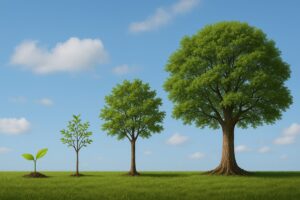 Trees are some of the longest-living and most valuable organisms on Earth. They quietly support ecosystems, provide shelter for wildlife, clean our air, offer shade, and even add significant value to our homes and communities. But have you ever wondered what a tree’s life looks like from start to finish? Let’s explore the fascinating lifecycle of a tree—from its earliest days as a seedling to its role as a mature, towering giant.
Trees are some of the longest-living and most valuable organisms on Earth. They quietly support ecosystems, provide shelter for wildlife, clean our air, offer shade, and even add significant value to our homes and communities. But have you ever wondered what a tree’s life looks like from start to finish? Let’s explore the fascinating lifecycle of a tree—from its earliest days as a seedling to its role as a mature, towering giant.
Stage 1: The Humble Beginning—Seed and Germination
Every tree starts its life as a seed. Seeds can be small and light, like a maple’s whirligig, or large and robust, like an acorn. Each seed contains all the genetic information needed to grow into a full-sized tree, provided it finds the right conditions.
Germination is triggered when the seed finds itself in a suitable environment—moist soil, the right temperature, and plenty of nutrients. The outer coat softens, allowing the embryonic root (called the radicle) to push downward, anchoring the seed. Soon after, the shoot (plumule) grows upward, breaking through the soil’s surface. At this delicate stage, the tiny seedling is vulnerable to drought, disease, and animals. Careful watering, weeding, and sometimes protective cages are necessary for survival.
Stage 2: Seedling—Tender Growth
As the seedling grows, it begins to develop its first true leaves, allowing it to photosynthesize and produce its own food. This is a critical growth phase. Roots grow deeper and branches spread wider, but the young tree is still at risk from environmental hazards—strong winds, trampling, or lack of water.
Arborists recommend mulching around seedlings, monitoring soil moisture, and keeping weeds at bay. For urban plantings, protecting young trees from mowers and foot traffic is essential.
Stage 3: Sapling—Entering Adolescence
After a few years, the seedling becomes a sapling—taller and stronger, but not yet mature. Saplings usually range from 1 to 4 inches in trunk diameter and can grow rapidly under the right conditions. This stage can last several years, depending on species and environment.
At this stage, formative pruning is important. Properly shaped branches will create a strong structure for future growth. Removing crossing or weak branches early can prevent bigger problems later. This is also when trees are most susceptible to mechanical injuries and pest infestations, so regular checks are crucial.
Stage 4: Maturity—A Fully Grown Tree
After years of steady growth, the sapling transforms into a mature tree. This stage can last decades—or even centuries! Mature trees provide immense ecological benefits: shade, oxygen, habitat for birds and insects, and beauty for our landscapes. They also help regulate local temperatures and reduce stormwater runoff.
Mature trees require less frequent, but still important, care. Regular inspections for disease, pests, and structural problems are necessary. Pruning may be needed to remove deadwood or maintain shape, but it should be done carefully to avoid stressing the tree.
Stage 5: Old Age and Renewal—The Cycle Continues
Even the mightiest tree ages. Signs of decline include reduced leaf size, fewer branches, or deadwood. Old trees are incredibly valuable—they often host unique wildlife and fungi, and their hollow trunks can provide shelter for birds and mammals.
Eventually, a tree will die and begin to decompose, enriching the soil and paving the way for new life. In forests, fallen trees become “nurse logs,” supporting seedlings and the next generation of growth.
Why Understanding the Lifecycle Matters
Recognizing each stage in a tree’s lifecycle helps homeowners and property managers provide the right care at the right time. Young trees need protection and formative pruning, while mature trees benefit from regular inspections and selective maintenance. And even aging trees deserve respect and thoughtful care, as they contribute to the ecosystem long after their prime.
Are you ready to plant a new tree or care for the ones you have?
Contact New Day Arborist for expert guidance at every stage of a tree’s life—from seedling to majestic elder. Let’s grow something amazing together!